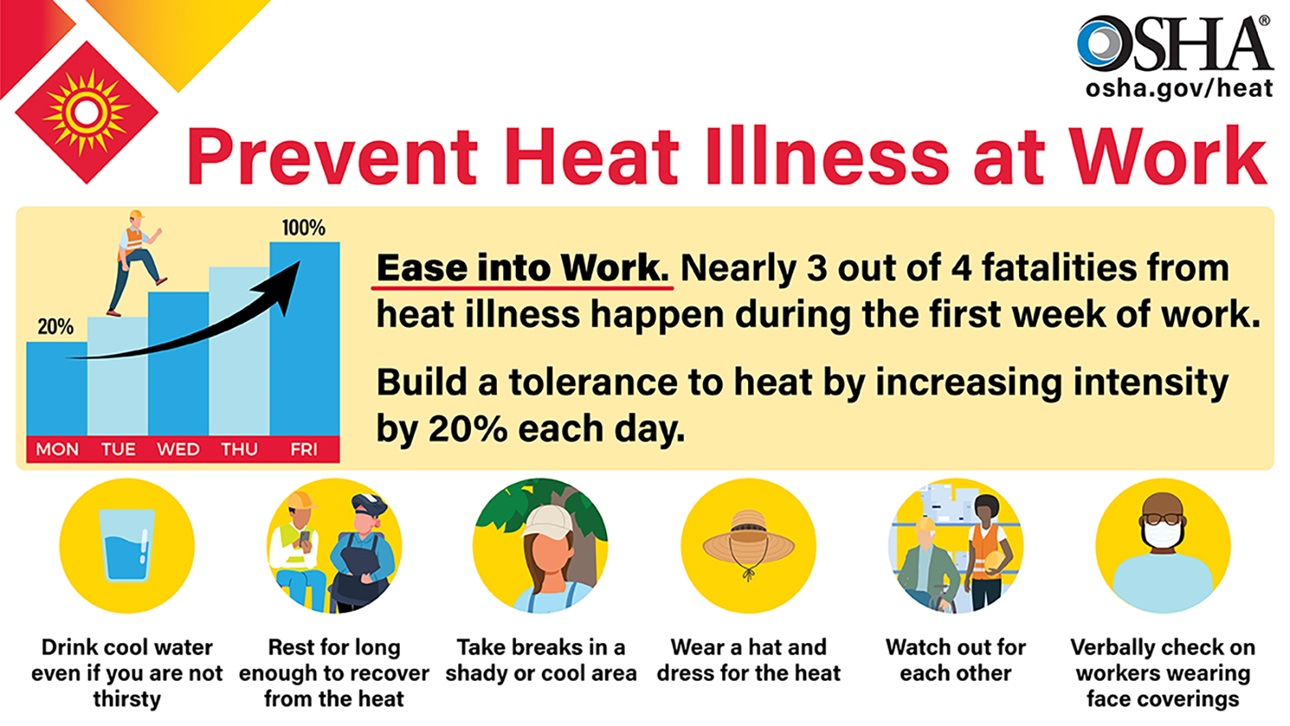
Workers whose jobs require them to be outside should be prepared to take precautions to protect against possible heat related illnesses and/or injuries. Individual workers react to heat based on their own individual characteristics and multiple factors such as environmental conditions (temperature, wind, sun, and humidity), acclimation to working in warmer conditions, their own personal health, and the extent of their physical activity.
Employers and workers should be sure to have plans in place to provide access to plenty of water, take adequate breaks when needed, as well as access to shade or cool-down areas. Employers and workers should also consider shifting work schedules to times of day when temperatures are lower, such as early morning to mid-day.
What is Heat Illness?
Exposure to excessive heat can cause injury or death. When working in a hot environment, especially when physically active, the human body relies on its ability to get rid of excess heat (heat dissipation) to maintain a healthy internal body temperature. Heat dissipation happens naturally through sweating and increased blood flow to the skin. Workers cool down more rapidly when the external temperature and physical activity are reduced.
If heat dissipation does not happen quickly enough, the internal body temperature keeps rising and the worker may experience symptoms that include thirst, irritability, rash, cramping, heat exhaustion, or heat stroke.
The most serious heat illness is heat stroke. Symptoms of heat stroke include:
- Confusion, disorientation, slurred speech, unable to think clearly, collapse, unconsciousness, or potential seizures.
- No sweating.
If a worker is experiencing heat stroke, cool workers immediately and call 911.
How Hot is Too Hot?
Excessive body temperature results from an imbalance in the equilibrium of heat gain (from internal work and external temperature) and heat loss, primarily from evaporative cooling, or sweat evaporation. Risk factors for heat illness include:
- High temperature and humidity, direct sun exposure, no breeze or wind
- Heavy physical labor
- No recent exposure to hot workplaces
- Dehydration
- Wearing waterproof clothing
- Individual/personal risk factors, (e.g., medical conditions, lack of physical fitness, lack of acclimation, previous episodes of heat-related illness, alcohol consumption, drugs, and use of certain medication.)
All factors that contribute to body temperature increase should be considered when determining if a heat hazard is present in a workplace.
How Can Heat Illness be Prevented?
Heat-related illness is preventable. There are precautions that can be taken any time temperatures are high and the job involves physical work.
- Establish a heat illness prevention plan.
- Workers who have not spent time recently in warm or hot environments and/or being physically active will need time to build tolerance or acclimatize to the heat.
- Have workers drink plenty of fluids and preferably water every 15 minutes to stay hydrated and avoid beverages containing caffeine.
- Review the upcoming week’s weather forecast and have workers to wear light weight, light colored, and loose fitted clothing.
- Modify work schedules and allow workers to take frequent breaks.
- When possible, block out direct sun light or provide shaded rest areas for workers.
- Consider protective clothing that provides cooling.
- Monitor workers throughout the shift and quickly identify any heat illness symptoms.
- Keeping Workers Safe in the Heat comes down to: WATER. REST. SHADE.




